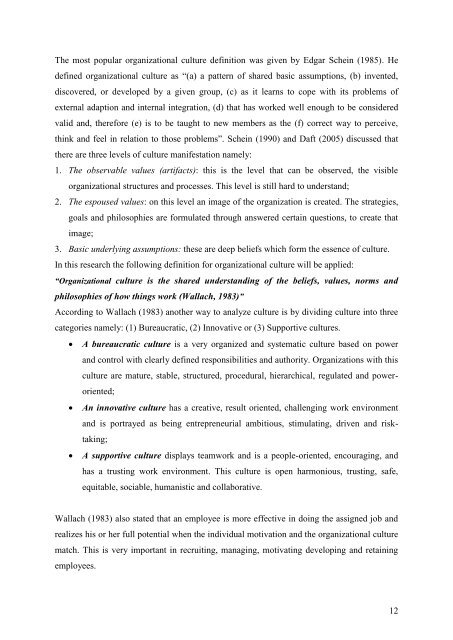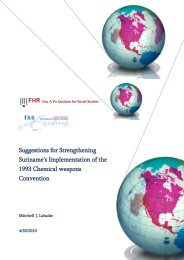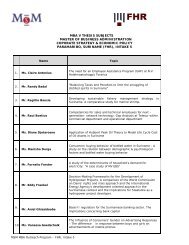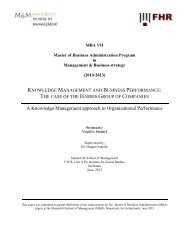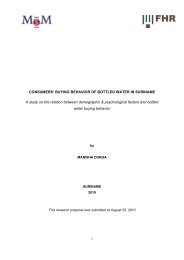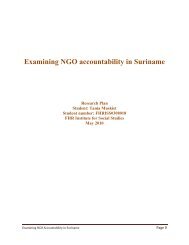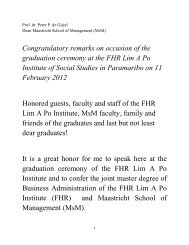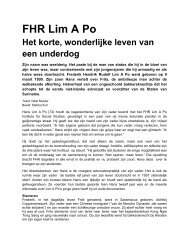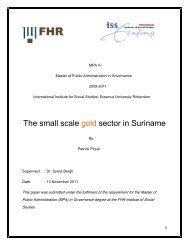The most popular organizational culture definition was given by Edgar Schein (1985). Hedefined organizational culture as “(a) a pattern of shared basic assumptions, (b) invented,discovered, or developed by a given group, (c) as it learns to cope with its problems ofexternal adaption and internal integration, (d) that has worked well enough to be consideredvalid and, therefore (e) is to be taught to new members as the (f) correct way to perceive,think and feel in relation to those problems”. Schein (1990) and Daft (2005) discussed thatthere are three levels of culture manifestation namely:1. The observable values (artifacts): this is the level that can be observed, the visibleorganizational structures and processes. This level is still hard to understand;2. The espoused values: on this level an image of the organization is created. The strategies,goals and philosophies are formulated through answered certain questions, to create thatimage;3. Basic underlying assumptions: these are deep beliefs which form the essence of culture.In this research the following definition for organizational culture will be applied:“Organizational culture is the shared understanding of the beliefs, values, norms andphilosophies of how things work (Wallach, 1983)”According to Wallach (1983) another way to analyze culture is by dividing culture into threecategories namely: (1) Bureaucratic, (2) Innovative or (3) Supportive cultures. A bureaucratic culture is a very organized and systematic culture based on powerand control with clearly defined responsibilities and authority. Organizations with thisculture are mature, stable, structured, procedural, hierarchical, regulated and poweroriented; An innovative culture has a creative, result oriented, challenging work environmentand is portrayed as being entrepreneurial ambitious, stimulating, driven and risktaking; A supportive culture displays teamwork and is a people-oriented, encouraging, andhas a trusting work environment. This culture is open harmonious, trusting, safe,equitable, sociable, humanistic and collaborative.Wallach (1983) also stated that an employee is more effective in doing the assigned job andrealizes his or her full potential when the individual motivation and the organizational culturematch. This is very important in recruiting, managing, motivating developing and retainingemployees.12
2.4 Job satisfactionJob satisfaction has been a topic of interest among researchers for several decades (Currivan,1999; Lund, 2003) due to the fact that many experts (managers and researchers) belief that itcan affect and influence work productivity, employee commitment, employee turnover andemployee retention (Eslami & Gharakhani, 2012). Job satisfaction is the level to which anemployee is satisfied with his current work. This depends on how many of his/her needs andwants are satisfied (Finn, 2001). Job satisfaction is known as a construct with multi facetsthat includes the employee feelings about different job elements, intrinsic as well as extrinsic.It includes specific features of satisfaction associated with pay, benefits, supervision,organizational practices, promotion, work conditions and relationships with co-workers(Misener et al, 1996).In this research the following definition for job satisfaction will be applied:“Job satisfaction is the extent to which people like (satisfaction) or dislike (dissatisfaction)their jobs (Spector, 1997)”According to literature job satisfaction is influenced by several factors. Worrell (2004)divided these factors into three groups: Demographic data: age, gender and race; Intrinsic factors: achievement, recognition, work itself, responsibility, advancementand growth; Extrinsic factors: company policy, supervision, relationship with boss, workconditions, relationship with peers and salary.In this research the focus will be on the five factors of job satisfaction which are salary (pay),work itself (nature of the work), supervision, advancement and growth (promotionalprospects), relationship with peers. These factors correspond with the feelings, like or dislikeof their jobs, mentioned in the definition and are relevant to determining the level ofcommitment to an organization. Furthermore research (Randeree & Chaudhry, 2012) showedthat these factors strongly affect job satisfaction. Employees who feel satisfied with their jobare more productive and are likely to stay with the organization (Mc Neese-Smith, 1997).2.5 Organizational commitmentOrganizational commitment is an individual’s psychological attachment to the organization.The individual feel a sense of belonging and identification with the organization.13
- Page 1 and 2: FHR Lim A Po Institute for Social S
- Page 3 and 4: “Unless Commitment is made,there
- Page 5 and 6: ABSTRACTThe purpose of this study w
- Page 7 and 8: 2.7.2 Job satisfaction and Organiza
- Page 9 and 10: LIST OF FIGURESFigure 1-1Structure
- Page 11 and 12: 1 INTRODUCTION1.1 GeneralIn this ch
- Page 13 and 14: Different studies showed leadership
- Page 15 and 16: As mentioned earlier SME’s form t
- Page 17 and 18: 1.8 Outline of the Thesis structure
- Page 19 and 20: followers. The leaders influence an
- Page 21: 2. Transformational leadership anti
- Page 25 and 26: 2.6.1 General definition of SMEsThe
- Page 27 and 28: Job satisfaction is affected by the
- Page 29 and 30: 2.7.3 Organizational commitment and
- Page 31 and 32: 3 METHODOLOGY3.1 IntroductionThe li
- Page 33 and 34: large amounts of data. In a self-ad
- Page 35 and 36: Organizational Culture Index (OCI)T
- Page 37 and 38: Table 3-4Cronbach’s Alpha from Or
- Page 39 and 40: 4 FINDINGS AND ANALYSIS4.1 Introduc
- Page 41 and 42: Looking at the education level of t
- Page 43 and 44: 4.3 Descriptive statisticsThe main
- Page 45 and 46: Table 4-2 Correlation Matrix1 Trans
- Page 47 and 48: Step 3 Leadership variables, Cultur
- Page 49 and 50: 4.5.2 Regression analysis Leadershi
- Page 51 and 52: Table 4-8Model Summary Leadership s
- Page 53 and 54: ResearchQuestion 4ResearchQuestion
- Page 55 and 56: 4.7 SummaryDifferent analyses were
- Page 57 and 58: Bureaucratic culture has a direct p
- Page 59 and 60: satisfaction also has the largest e
- Page 61 and 62: 5.4 RecommendationsBased on the res
- Page 63 and 64: Bass, B., & Avolio, B. (1993). Tran
- Page 65 and 66: Eslami, J., & Gharakhani, D. (2012)
- Page 67 and 68: Lok, P., Wang, P., Westwood, B., &
- Page 69 and 70: Pallant, J. (2007). The SPSS Surviv
- Page 71 and 72: Walumba, F., & Lawler, J. (2003). B
- Page 73 and 74:
APPENDIXa
- Page 75 and 76:
Appendix B: The QuestionnairePart 1
- Page 77 and 78:
Part 2 Organizational cultureFor ea
- Page 79 and 80:
Part 3 Job satisfactionListed below


